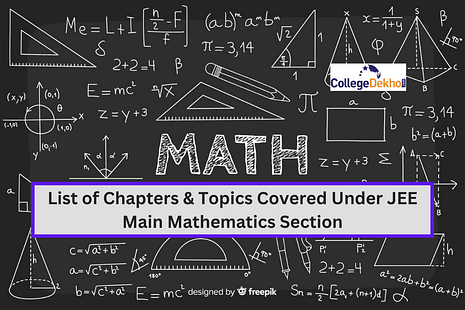
JEE Main 2026 Mathematics
: NTA has released the official JEE Main syllabus 2026 on the official website jeemain.nta.nic.in 2026. Mathematics is one of the key and toughest subjects of JEE Main where candidates have to exert much more pressure. It is very important for the candidates to know the chapters along with the topics and sub topics covered in the JEE Main 2026 mathematics exam so that they can formulate a strategic timetable with equal importance to all major areas. The Joint Entrance Exam (JEE) Main 2026 exam is conducted by NTA every year.
JEE Main 2026
is scheduled to be conducted in two phases.
In this article, we will discuss the JEE Main 2026 exam pattern, a list of important chapters and topics asked in the JEE Main mathematics exam, chapter-wise weightage, the best books for JEE Main 2026, and the preparation tips required for excelling in JEE Main 2026 mathematics exam.
Also read:
JEE Main 2026: Strategy to Score 90+ in Mathematics
JEE Main 2026 Mathematics Exam Pattern
Before checking the important topics of JEE Main 2026 Mathematics, it is very crucial for the candidates to understand the exam pattern of JEE Main 2026. Knowing the JEE Main exam pattern 2026 will ensure that the candidates are known about the facets of the JEE Main 2026 entrance exam.
Particulars | JEE Main Exam Details |
|---|---|
Exam | Joint Entrance Exam - JEE Main |
Subject to be discussed | Mathematics |
Type of questions to be asked |
|
Total Number of Questions |
|
Number of questions to be attempted |
|
Marking Scheme |
|
Also check: JEE Main 2026 Exam Pattern and Marking Scheme for B.Tech Paper 1
JEE Main Mathematics Chapter-Wise Topics 2026
The table below will highlight the topics covered in JEE Main 2026 syllabus for mathematics. For a better understanding of the candidates, we have mentioned the chapters and the topic along with it.
Units | Chapter | Topics |
|---|---|---|
1 | Set, Relations and Functions | Set, and their representation |
Union, intersection, and complement of sets and their algebraic properties | ||
Powerset | ||
Relation, Types of relations, equivalence relations | ||
Functions; one-one, into and onto functions, the composition of functions | ||
2 | Complex Numbers and Quadratic Equations | Complex numbers as ordered pairs of reals. |
Representation of complex numbers in the form (a+ib) and their representation in a plane, Argand diagram. | ||
Algebra of complex numbers, modulus and argument (or amplitude) of a complex number, square root of a complex number. | ||
Triangle inequality | ||
Quadratic equations in real and complex number system and their solutions. | ||
The relation between roots and coefficients, nature of roots, the formation of quadratic equations with given roots. | ||
3 | Matrices and Determinants | Matrices: Algebra of matrices, types of matrices, and matrices of order two and three. |
Determinants: Properties of determinants, evaluation of determinants, the area of triangles using determinants. | ||
Adjoint and evaluation of the inverse of a square matrix using determinants and elementary transformations. | ||
Test of consistency and solution of simultaneous linear equations in two or three variables using determinants and matrices. | ||
4 | Permutations and Combinations | The fundamental principle of counting. |
Permutation as an arrangement and combination is a selection. | ||
The meaning of P (n,r) and C (n,r). Simple applications. | ||
5 | Mathematical Induction | The Principle of Mathematical Induction and its simple applications. |
6 | Binomial Theorem | Binomial theorem for a positive integral index. |
General term and middle term. | ||
Properties of Binomial coefficients and simple applications. | ||
7 | Sequence and Series | Arithmetic and Geometric progressions, insertion of arithmetic. |
Geometric means between two given numbers. | ||
The relation between A.M. and G.M. | ||
Sum up to n terms of special series: Sn, Sn2, Sn3. | ||
Arithmetic Geometric progression. | ||
8 | Limit, Continuity, and Differentiability | Real-valued functions, algebra of functions, polynomials, rational, trigonometric, logarithmic, and exponential functions, inverse functions. |
Graphs of simple functions. | ||
Limits, continuity, and differentiability. | ||
Differentiation of the sum, difference, product, and quotient of two functions. | ||
Differentiation of trigonometric, inverse trigonometric, logarithmic, exponential, composite, and implicit functions; derivatives of order up to two. | ||
Rolle’s and Lagrange’s Mean Value Theorems. | ||
Applications of derivatives: Rate of change of quantities, monotonic increasing and decreasing functions, Maxima, and minima of functions of one variable, tangents, and normals. | ||
9 | Integral Calculus | Integral as an antiderivative. |
Fundamental integrals involving algebraic, trigonometric, exponential, and logarithmic functions. | ||
Integration by substitution, by parts, and by partial fractions. | ||
Integration using trigonometric identities. | ||
Integral as the limit of a sum. | ||
Evaluation of simple integrals | ||
Fundamental Theorem of Calculus. | ||
Properties of definite integrals, evaluation of definite integrals, determining areas of the regions bounded by simple curves in standard form. | ||
10 | Differential Equations | Ordinary differential equations, their order, and degree. |
Formation of differential equations. | ||
The solution of differential equations by the method of separation of variables. | ||
The solution of homogeneous and linear differential equations. | ||
11 | Coordinate Geometry | Cartesian system of rectangular coordinates in a plane, distance formula, section formula, locus, and its equation, translation of axes, the slope of a line, parallel and perpendicular lines, intercepts of a line on the coordinate axes. |
Straight lines: Various forms of equations of a line, intersection of lines, angles between two lines, conditions for concurrence of three lines. | ||
Distance of a point from a line, equations of internal and external bisectors of angles between two lines, coordinates of the centroid, orthocentre, and circumcentre of a triangle, and equation of the family of lines passing through the point of intersection of two lines. | ||
Circles, conic sections: Standard form of the equation of a circle, the general form of the equation of a circle, its radius and center, equation of a circle when the endpoints of a diameter are given, points of intersection of a line and a circle with the center at the origin and condition for a line to be tangent to a circle, equation of the tangent. | ||
Sections of cones, equations of conic sections (parabola, ellipse, and hyperbola) in standard forms, condition for y = MX + c to be a tangent and point (s) of tangency. | ||
12 | 3D Geometry | Coordinates of a point in space, the distance between two points. |
Section formula, direction ratios, and direction cosines, the angle between two intersecting lines. | ||
Skew lines, the shortest distance between them, and their equation. | ||
Equations of a line and a plane in different forms, the intersection of a line and a plane, coplanar lines | ||
13 | Vector Algebra | Scalars and Vectors. Addition, subtraction, multiplication, and division of vectors. |
Vector’s Components in 2D and 3D space. | ||
Scalar products and vector products, triple products. | ||
14 | Statistics and Probability | Measures of Dispersion: Calculation of mean, mode, median, variance, standard deviation, and mean deviation of ungrouped and grouped data. |
Probability: Probability of events, multiplication theorems, addition theorems, Baye’s theorem, Bernoulli trials, Binomial distribution, and probability distribution. | ||
15 | Trigonometry | Identities of Trigonometry and Trigonometric equations. |
Functions of Trigonometry. | ||
Properties of Inverse trigonometric functions. | ||
Problems on Heights and Distances. | ||
16 | Mathematical Reasoning | Statements and logical operations: or, and, implied by, implies, only if and if. |
Understanding of contradiction, tautology, contrapositive, and converse. |
Also check: JEE Main 2026 Most Important Topics for Mathematics with Weightage
Chapter-Wise Weightage For JEE Main 2026 Mathematics Section
Since the important topics based on JEE Main 2026 Mathematics are discussed above, candidates should also know the chapter-wise weightage. This will boost their preparation and they will be able to figure out the topics that will be asked from the most to least in the JEE Main Mathematics exam 2026.
The table below highlights the chapters asked in the JEE Main 2026 Mathematics exam along with the number of questions, and marks in ascending order.
Mathematics Chapter Weightage for JEE Main 2026 | ||
|---|---|---|
Chapter | Number of Questions | Total Marks |
Sets, Relation, and Function | 1 | 4 |
Binomial Theorem and Its Application | 1 | 4 |
Sequences and Series | 1 | 4 |
Trigonometry | 1 | 4 |
Mathematical Reasoning | 1 | 4 |
Differential Equation | 1 | 4 |
Differential Calculus | 1 | 4 |
Statics and Dynamics | 1 | 4 |
Permutations and Combinations | 1 | 4 |
Statistics and Probability | 2 | 8 |
Complex numbers and Quadratic Equation | 2 | 8 |
Vector Algebra | 2 | 8 |
Matrices and Determinants | 2 | 8 |
Three Dimensional Geometry | 2 | 8 |
Integral Calculus | 3 | 12 |
Limits, Continuity and Differentiability | 3 | 12 |
Coordinate Geometry | 5 | 20 |
Note: The above weightage given in the table is variable in nature and may be subject to change.
Also check: List of High Scoring Topics in Mathematics for JEE Main 2026
Best Books for JEE Main 2026 Mathematics Section
For healthy preparation of JEE Main 2026 Mathematics, candidates should make sure that they are referring to the best reference books in the market. NCERT books of classes 11 and 12 are the basic for all the Mathematics preparation. Apart from the NCERT books, candidates should also refer to the reference books. While referring to these books there are certain things that have to be kept in the market. Firstly, these reference books should be written by an authorized author. Secondly, these books should cover the entire syllabus of JEE Main 2026 mathematics, have authentic and upto date information.
The table below highlights the JEE Main 2026 books along with their authors/ publishers.
JEE Main 2026 Best Books For Mathematics | Authors |
|---|---|
Objective Mathematics for JEE | R.D. Sharma |
Degree level Differential Calculus | A Das Gupta |
Higher Algebra | Hall and Knight |
IIT Mathematics | M.L. Khanna |
Problems in Calculus of One Variable | I.A. Maron |
Mathematics for Class 11 and 12 | R.D. Sharma |
JEE Main 2026 Mathematics Preparation Plan
If planning to prepare for JEE Main Mathematics 2026 exam and finding it difficult, candidates are entitled to follow certain steps to reach success in the Mathematics section.
- Always start early. Starting early will make sure that the topics get much time and in the end, there is enough time for revision
- Understand the exam pattern of JEE Main and syllabus
- Prepare a timetable. Try preparing the timetable in such a way that all the topics are covered and equal time is invested in each topic. It should be made in such a way that all the activities are included in it- study hours, meal time, breaks, sleeping time, and required rests
- Make notes of the formulas and theories. Adapting the habit of making notes of the topics learned will ensure that it is handy and can be reached easily whenever required
- Refer to the best books for JEE Main 2026 preparation for mathematics as mentioned above in the table
- Revision is the key to success. Studying and learning the problems in mathematics won't help in this case. Practice the topics thoroughly until a clear understanding is extracted.
- Time management skill is the key ingredient in the JEE Main 2026 preparation . Practice the JEE Main question papers and mock tests so that there is a proper balance in the time management skill, knowledge about the questions asked in the past years, and also the exam paper pattern is seized
- Lastly, take care of your health, meditate and listen to soft music. This will ensure that there is proper concentration while preparing
For more news and updates on JEE Main 2026, stay tuned with Collegedekho!
Are you feeling lost and unsure about what career path to take after completing 12th standard?
Say goodbye to confusion and hello to a bright future!

FAQs
Following are the important chapters with more weightage for JEE main 2023 mathematics; 3-dimensional geometry, vectors, determinant and matrices, sequence and series, straight line, circle, probability distribution, definite integral and area under the curve, limits, continuity, and differentiability, functions, application of derivatives, conic sections, binomial theorem, complex numbers, and quadratic equations.
Some of the best reference books for JEE Main mathematics are listed below.
- Objective Mathematics for JEE by R.D. Sharma
- Degree level Differential Calculus by A Das Gupta
- Higher Algebra by Hall and Knight
- IIT Mathematics by M.L. Khanna
As per the previous year's analysis, coordinate geometry and differential calculus has the highest weightage in the JEE Main 2023 mathematics exam.
Yes, definite integrals are included in the syllabus of JEE Main 2023 Maths.
A total of 30 questions are asked in the JEE Main mathematics exam 2023 from which only 25 questions have to be attempted.
Since JEE Main is a national level entrance exam, and the competition is high, all the chapters in mathematics are of equal importance. You cannot skip any chapters for JEE Main mathematics.
NCERT books form the base of the class 11 and 12 preparation. Apart from the NCERT books, candidates can also refer to the reference books available in the market covering the syllabus of JEE Main mathematics and written by an authorized author
No, there are no changes made in the mathematics syllabus of JEE Main 2023.
Was this article helpful?





















Similar Articles
Are JEE Main Study Groups Worth It? Detailed Pros and Cons for 2026 Aspirants
How to Prioritize Physics Chapters Based on JEE Main 2026 Weightage and Difficulty
GATE 2026 Mechanical Engineering Expected No. of Questions Topic-Wise
GATE 2026 Civil Engineering Expected No. of Questions Topic-Wise
JEE Main 2026 Physics High Priority and Low Priority Chapters
JEE Main 2026 Mathematics High Priority and Low Priority Chapters